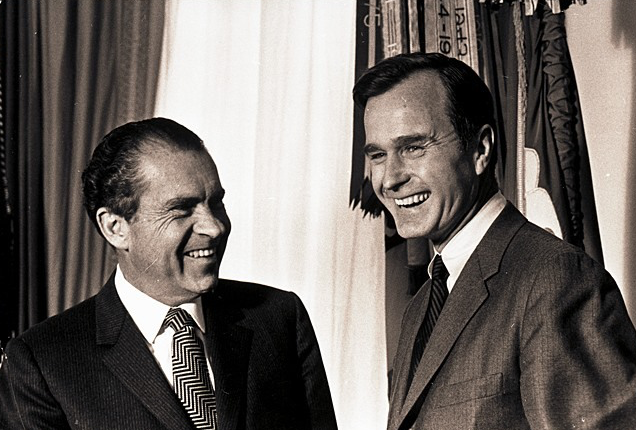President Richard Nixon with George H.W. Bush upon being appointed U.S. Ambassador to the United Nations. 12 January 1970 (George H.W. Presidential Library).
On Christmas Day 1990, three weeks before United States’ forces launched Operation Desert Storm to expel the Iraqi army occupying the Gulf country of Kuwait, former President Nixon penned an extensive nine-page memorandum to then President George H.W. Bush which discussed the various strategic options available to the United States in responding to Iraq’s aggression against its neighbor and the larger threat Iraq’s action posed to the Middle East.
The former president relayed the pros and cons of sanctions, diplomacy, military action, and the short and long term political implications of these critical decisions, but not before complimenting his successor for his “brilliant leadership and diplomacy” in enlisting the “largest alliance in history to support the goals of forcing Saddam Hussein to get out of Kuwait.”
The Christmas memo arrived on President Bush’s desk as the clocked ticked down to the January 15, 1991 deadline declared by the United Nations for Iraqi dictator Saddam Hussein to remove his forces from Kuwait.
Nixon made clear that he did not believe imposing sanctions on Iraq would be sufficient to force Saddam to withdraw from Kuwait. While acknowledging that sanctions caused hardship on Iraq’s domestic economy, Nixon asserted that without military action, a sanctions only approach would only allow the tide of time to work against the coalition that Bush assembled to contain Iraq.
Nixon urged Bush to conduct diplomacy only from a position of strength, with certain conditions first in place. Likening Kuwait to a kidnapper’s captive, Nixon wrote that paying the ransom will inevitably embolden Hussein and would, in the end, lead to a bigger war. “The critics who oppose use of force are destroying any chance to a negotiated peace by diplomacy,” he emphasized.
Consistent and coherent communication was absolutely critical to this effort, Nixon maintained. Critics of military action complain, “Why are we there?” How the United States answered that question was key to President Bush’s ability to win support for his determination to drive Iraq out of Kuwait.
Nixon asserted that answering that question with economics, employment, or energy wouldn’t sufficiently explain the bigger picture. He also maintained that defending military action on humanitarian terms would also be mistake. Saddam might be a cruel dictator, but “we cannot raise the issue with clean hands.” Furthermore, genocide and other humanitarian crises in other parts of the world had not warranted an American military response.
For Nixon, if war comes, it wouldn’t be a war for democracy, oil, or humanitarianism. “Ironically, it will above all be a war about peace.”
Addressing the birth pangs of what Bush would call the “New World Order” which was taking shape after the end of the Cold War, Nixon posited that the United States must demonstrate that military aggression to expand a nation’s influence in strategically important parts of the world would not stand. “If we succeed in forcing Saddam Hussein to withdraw by military action,” Nixon wrote, “it will mean that in the future a warning by the United States that we will use military force will deter a potential aggressor because he will know that we have the means and will to back up our words with actions.”
On the domestic political front, Nixon counseled Bush on gaining political support for military action. He believed a joint resolution from Congress would be ideal, but would initiate long debate, and take away from the executive branch the power to wage war and peace.
Recalling his spring 1972 decision to bomb Hanoi and mine Haiphong Harbor, Nixon said one option would be to assemble a bi-partisan group of leaders, brief them on what has been decided, and ask for their support:
Some of them [Congressional leaders assembled in spring 1972] were unhappy, but when the polls came out showing that the decision was overwhelmingly popular and when the Soviets, contrary to predictions of most diplomatic experts, went ahead with the summit, it was hard to find any one of the leaders present at the briefing who had not supported it all out from the very beginning.
Bush would achieve overwhelming support in the United States for his decision to attack Iraqi forces in Kuwait.
Finally, Nixon outlined long range issues. He agreed with Bush about not linking a settlement on the Israeli-Palestinian issue with Saddam’s withdrawal from Kuwait, as it would be interpreted as a reward for aggression against the Gulf country.
Nixon also insisted that Japan and Western Europe quadruple their paltry financial contribution to the military effort. Japan, for example, received 60 percent of its oil from the Gulf (the U.S. received just 10 percent) and would stand the most to benefit from American intervention.
Nixon concluded on a particularly high note to his successor, writing that history would not only record Bush as a Commander in Chief able to forge victory in war, but also as “an outstanding statesman in winning the peace after the war was won.”
Bush, who gained much of his foreign policy and intelligence experience and expertise while serving as Nixon’s ambassador to the United Nations, essentially carried out the strategy Nixon outlined in his Christmas memo. The day after the U.N.’s January 15, 1991 deadline passed, Operation Desert Storm was underway, leading to the liberation of Kuwait just 45 days later.
Read the entire memorandum below:
Options in the Gulf. by richardnixonfoundation on Scribd

